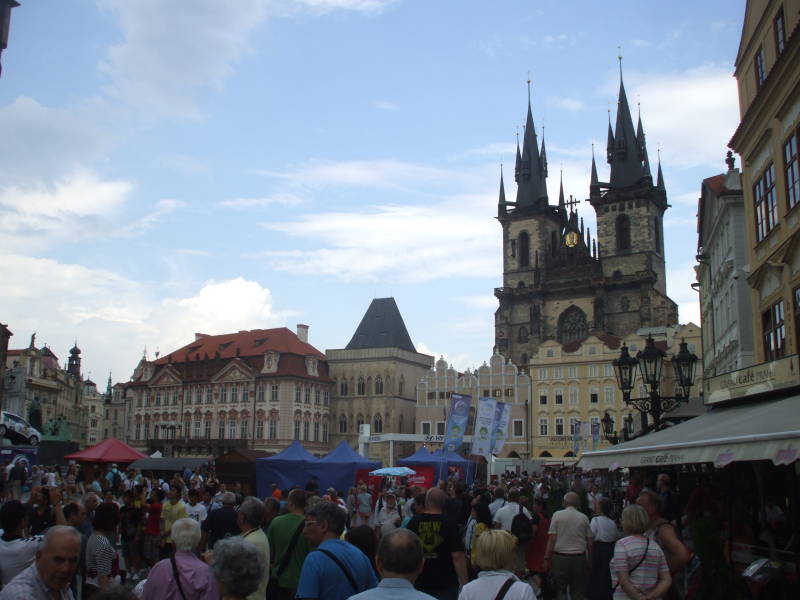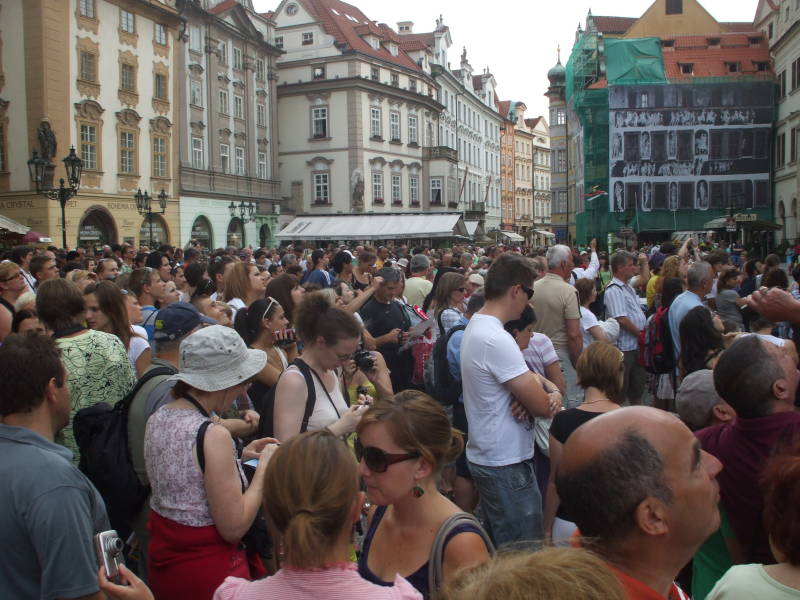
Prague, Czech Republic
Sightseeing in Prague
Athens to Parisby Train
We have just arrived in Prague on a train from Budapest, Hungary. This is part of the Athens to Paris by Train series, start at the beginning to get the background and the details so far.
Prague, or Praha as the locals know it, has been an important political, cultural and economic center over the past 1,100 years. The area was populated back in the Paleolithic age. The Celts had a settlement here by 200 BC. The first permanent settlement in today's Prague was a simple fortress of wooden buildings, built by the year 800 AD where Prague Castle now overlooks the Vltava River.
Bohemia's dukes, later elevated to the status of kings, were based in Prague. It became the seat of a Roman Catholic bishop in 973, well after the visits by the Macedonian missionary brothers Cyril and Methodius.
Prague really prospered under the 1346-1378 reign of Charles IV, the King of Bohemia and the Holy Roman Emperor. He directed the construction of a bridge and cathedral that are major sights today.
King Wenceslaus IV, Charles' son, was not the "Good King Wenceslas" of the Christmas song. That one was Wenceslaus I, Duke of Bohemia 907-935, assassinated by his brother Boleslav the Cruel and later considered a martyr and the patron saint of the Czech nation. No, Wenceslaus IV was nicknamed "Wenceslaus the Idle" and was King of Bohemia 1378-1419. He was recognized as King of Germany for a while, then was deposed when he took an unpopular side in one of the Papal schisms. He managed to hold on to his position as King of Bohemia. During his rule the Prague clergy announced that Jews had descrated the Eucharistic wafer and encouraged mobs to pillage and burn the large Jewish quarter. Nearly all 3,000 members of Prague's Jewish population were killed.
Jan Hus began presenting sermons attempting to radically reform what he saw as a corrupt church. So, he was summoned before the Council of Constance, tried for heresy, and burned at the stake in 1415.
Defenestrations
The Defenestrations of Prague began soon after. The First Defenestration of Prague happened on 30 July 1419. The Hussite priest Jan Želivský led his congregation through the streets of Prague to the New Town Hall, where the town council members were holding some Hussites prisoner. Someone threw a rock from a window of the town hall at Želivský and thereby enraged his mob. They stormed the town hall and threw the judge, the burgomaster, and thirteen members of the town council out the window. Those who weren't killed by the fall were killed by the rest of the mob. King Wenceslas IV, "The Idle", was said to have been so troubled by this that the shock contributed to his death by heart attack just over two weeks later. The defenestration definitely led to the Hussite Wars, which lasted until 1436.
The Second Defenestration of Prague led to the Thirty Years' War of 1618-1648, one of the most destructive wars in European history. Its cause was a complicated mix of Roman Catholic versus Protestant conflict plus the impatience of assorted heirs apparent and would-be usurpers. On 23 May 1618, a Protestant group delivered a grievance to the Catholic Lord Regents in the Bohemian Chancellory of Prague Castle. The Catholics wanted to consult with their superior, the Protestants were impatient, and the Catholic Regents and their secretary were thrown out the third floor window. It was a 70 foot drop, but they landed in a large pile of manure in a dry moat and survived.
Then there was the defenestration referred to as the One-and-Halfth Defenestration of Prague. It happened on 24 September 1483, between the more prominent First and Second Defenestrations. The municipal governments of the Old and New Towns were violently overthrown. The portreeve of the Old Town and seven of the aldermen were thrown out the windows of their respective town halls.
A long time then passed without major defenestrations, but on 10 March 1948 Jan Masaryk, the Czechoslovak Foreign Minister, was found dead on the ground below the bathroom window of the Ministry of Foreign Affairs. This was officially ruled to be a suicide, but it is believed that he was assassinated by either the Soviet secret services or elements of his own government. Confusingly, this is called the Third Defenestration of Prague, although if we count the One-and-Halfth Defenestration, this would really be the Fourth Defenestration of Prague.
Amazon
ASIN: 0241306221
Amazon
ASIN: 1786571587
Rudolf II was a later combined King of Bohemia and Holy Roman Emperor 1576-1612. He was rather obsessed with the occult, he was a devotée of astrology and alchemy with a lifelong interest in finding the Philosopher's Stone.
Czechoslovakia was founded in 1918 as the union of Bohemia, Moravia, Silesia, Slovakia, and Ruthenia after the First World War. Prague was its capital. Then, when Czechoslovakia was split into the Czech Republic and the Slovak Republic, also known as Czechia and Slovakia, Prague remained capital of its country.
Charles Bridge
Holy Roman Emperor and King of Bohemia Charles IV personally laid the first foundation stone for this bridge, which came to be known as the Charles Bridge, at 5:31 AM on 9 July 1357. The royal astrologers and royal numerologists had declared that the palindromic number 135797531 (as in 1357 9 VI 5:31) was an especially auspicious time for initiating bridge construction.
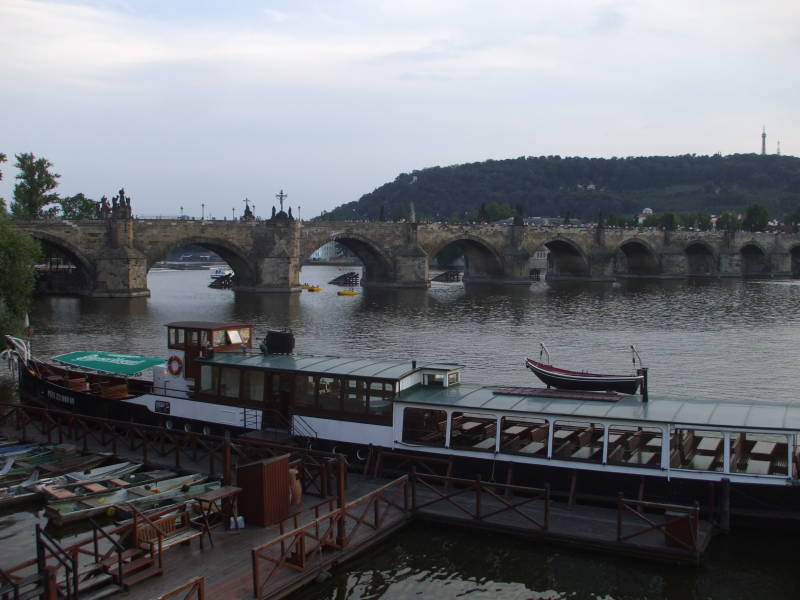
And here we thought that we had to wait for Rudolf II, King of Bohemia and Holy Roman Emperor 1576-1612, to find a strangely obsessed Czech leader.
There is a large arched tower at each end of the bridge. A statue of Charles IV stands beside the east end.
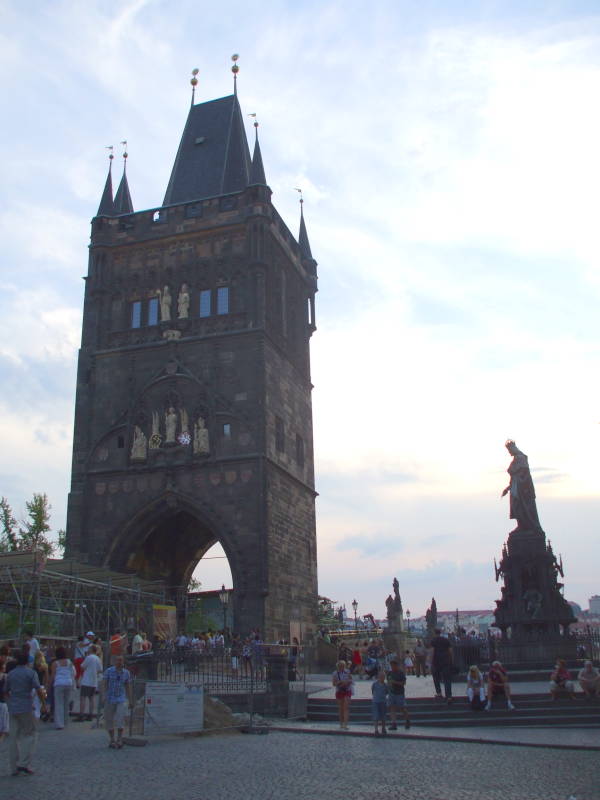
My parents are crossing the Charles Bridge across the Vltava River. That's the Prague Castle and the Cathedral of Saint Vitus in the background.
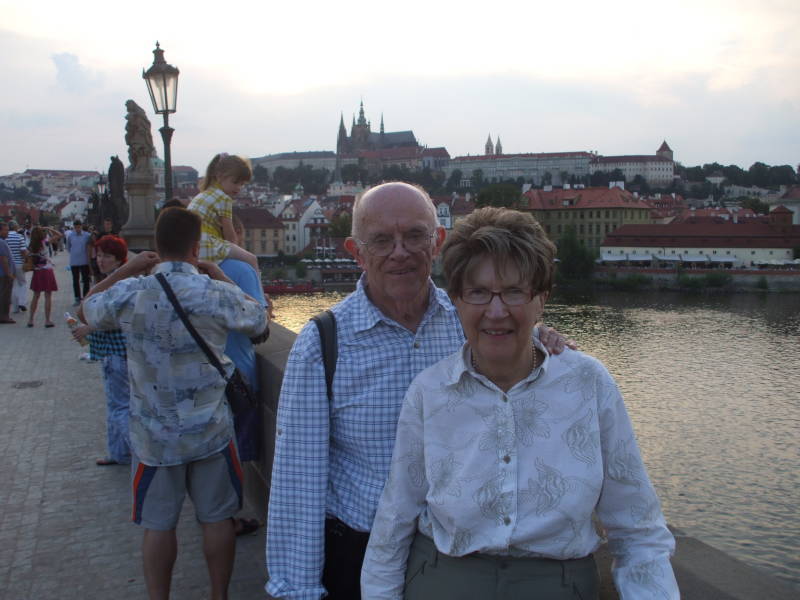
The Charles Bridge is filled with artists, vendors and performers, it is one of the most obvious tourist locations in Prague.
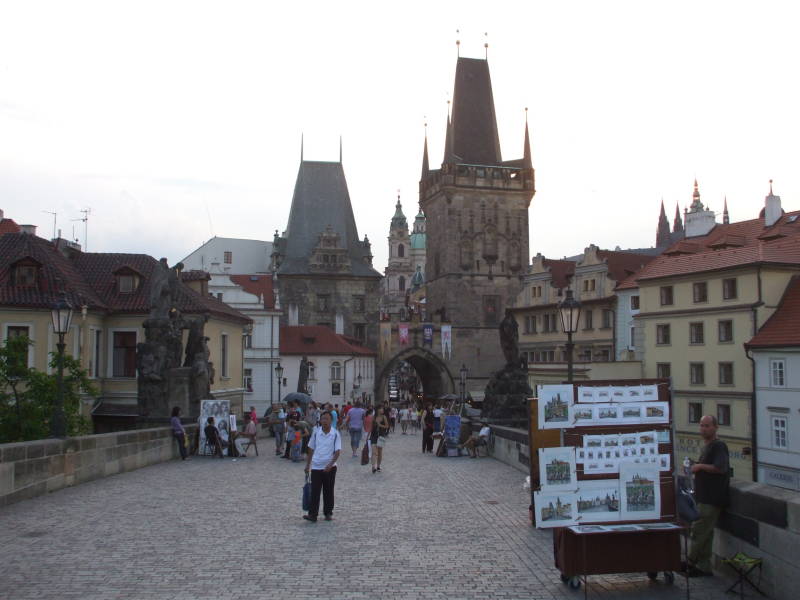
The arched tower at the west end of the Charles Bridge leads into the twisting streets below Prague Castle.
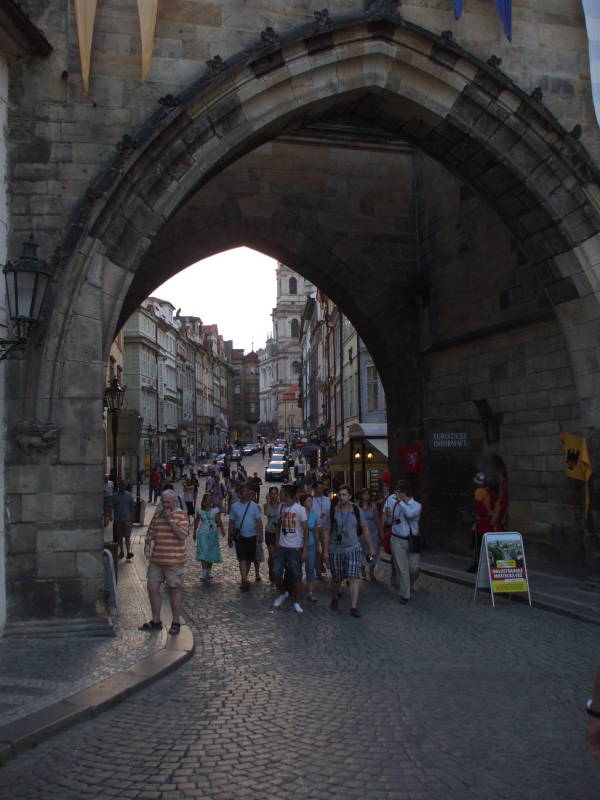
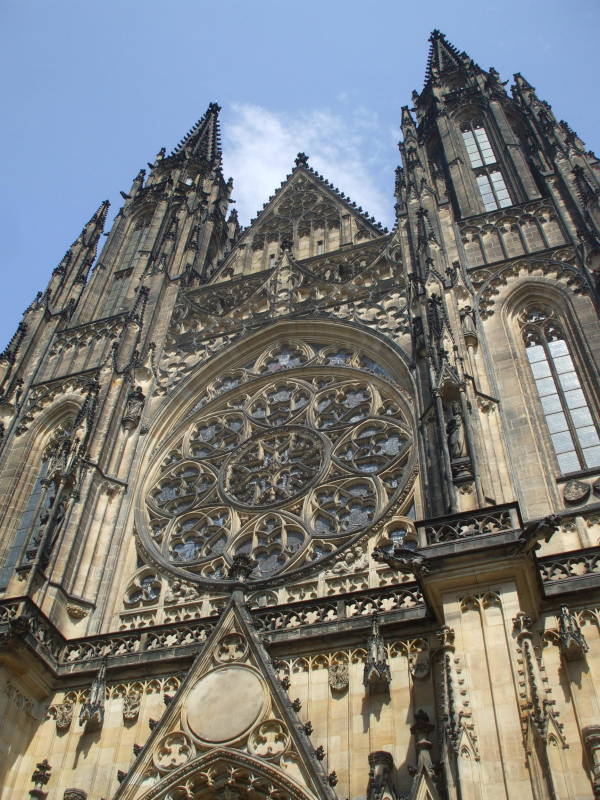
Saint Vitus Cathedral
The Cathedral of Saint Vitus is the third church on this site within Prague Castle. The first was founded by Wenceslaus I (the Good King and not The Idle) in 925. A larger basilica was built starting in 1060, and this Gothic cathedral was started in 1344.
As for the 925 original, Holy Roman Emperor Henry I had given Wenceslaus I a holy relic: the hand of Saint Vitus. There is also a theory that Wenceslaus thought it would be easier to convert his people to Christianity if it were based around a saint with a name very similar to that of the Slavic sun deity Svantovit, the god of war, fertility and abundance.
Vitus was from Sicily, believed to have been killed for his belief under the Roman Emperor Diocletian around 303 AD. A purely legendary description of the martyrdom of Vitus, Modestus and Crescentia evolved during the 6th and 7th centuries, based on other legends, especially that of Poitus, with the addition of fantastic miracles.
According to this legend, Vitus was the son of a Roman senator of Lucania — some versions have him just seven years old at the time, others say twelve. His father tortured him in an attempt to make him renounce his faith. Vitus fled this treatment with his tutor, Modestus, and Modestus' wife, Crescentia, who was also Vitus' nanny. They fled to Lucania, then took Vitus to Rome so he could exorcise a demon who had taken possession of Emperor Diocletian's son. As soon as he succeeded, Diocletian rather ungratiously started torturing the three of them. An angel miraculously transported them to Lucania, where they died of their injuries. Then three days later, Vitus appeared to a local older woman and told her where to find the bodies so they could be buried.
Vitus became a popular (if legendary) martyr quickly. Pope Gelasius I, who held office 492-496, mentions a shrine to Vitus in Rome. Vitus is typically shown as Child Soup, a young boy being boiled in a large pot. According to the details of the legend, he was thrown into a cauldron of boiling tar and molten lead but miraculously was unscathed. His fatal injuries were due to some other perhaps less picturesque maltreatment.
Lead melts at 327.46 °C and boils at 1749 °C. While tar would boil at a much lower temperature, I would assume that "boiling" is used metaphorically within this legend.
Some bones labeled as the relics of Saint Vitus were brought to the monastery of St-Denis, north of Paris, in 756. They were given to the abbot of Corvey Abbey in northwestern Germany in 836. Interest in him spread through northern and eastern Germany and beyond that into some of the Baltic nations. A pattern of manic dancing in front of his statue developed through German and Latvian land. In 925, King of Germany and Holy Roman Emperor Henry I gave the bones of one hand of Saint Vitus to Wenceslaus I.
The manic dancing on Saint Vitus' feast day evolved into the dancing mania sometimes called Saint Vitus' Dance. This is now thought to be a mass psychogenic illness in which groups of people, up to several thousand at a time, would dance uncontrollably and bizarrely while screaming, singing, and claiming to have visions or hallucinations. This would continue until the people collapsed from exhaustion. Or, as in an episode in 1278 in Germany, until the bridge on which hundreds of them were dancing collapsed into the River Meuse.
The first such outbreak appeared in the 7th century, and they appeared across northwestern Europe until they stopped abruptly around the 17th century. One of the earliest described in detail was in the 1020s in Bernburg and involved just 18 sufferers. One in 1237 involved a large group of children jumping and dancing all the way from Ernfurt to Arnstadt, and may have been related to the legend of the Pied Piper. In 1373 and 1374 major episodes were reported in England, the Netherlands, and Germany. Following years brought many more throughout Europe.
The Dancing Plague of 1518 was an episode in Strasbourg that lasted at least a month in total. Individuals would succomb to the mania and dance for up to four to six days. Some of them died from heart attack, stroke or simply from exhaustion. Local physicians helpfully ruled out astrological and supernatural causes and blamed it on "hot blood". But instead of bleeding the sufferers, probably to further deaths, the local authorities set aside public buildings for dancing space in the belief that the sufferers simply had to get the dancing out of their systems.
It is now known that a common after-effect of acute rheumatic fever can cause rapid and uncoordinated jerking movements of the face, feet and hands. This is now known as Sydenham's chorea for the physician who first recorded his observation of the pattern. However, this is almost entirely limited to children and only very rarely is seen in adults. Most victims of the European dancing mania were adults (other than that Pied Piper incident). There is some belief that ergotism might have been involved, and some speculation about widespread occult practices, but most historians consider the widespread dancing mania to have been a form of mass hysteria.
Andy Warholin New York
Andy Warhol and Michael Caine both had severe rheumatic fevers as young children and developed the symptoms of Sydenham's chorea. Neither of them was boiled in tar and lead.
Amazon
ASIN: 1979464561
Amazon
ASIN: B00HRQ5ED8
The Gothic cathedral you see today was started in November of 1344. This was yet another project of Charles IV. But after the first thirty to forty years of construction, the cathedral remained only about half completed with very little progress over the next nearly 600 years. A "temporary" wall at the front of the transept marked the limit of progress.
Construction was restarted in the 1800s, starting with what was mostly repair work in 1861-1866. The nave's foundations were finally laid in 1870. Construction was finally completed in 1929!
The stained glass windows are amazing.
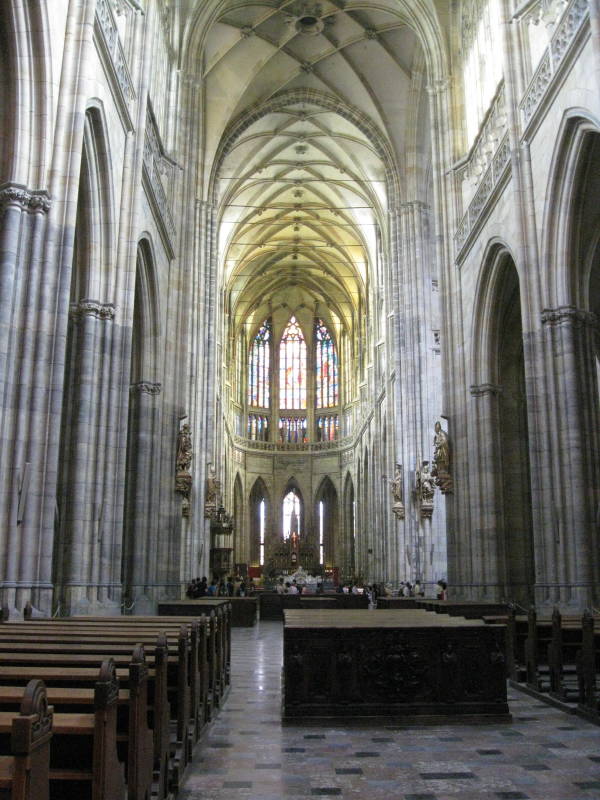
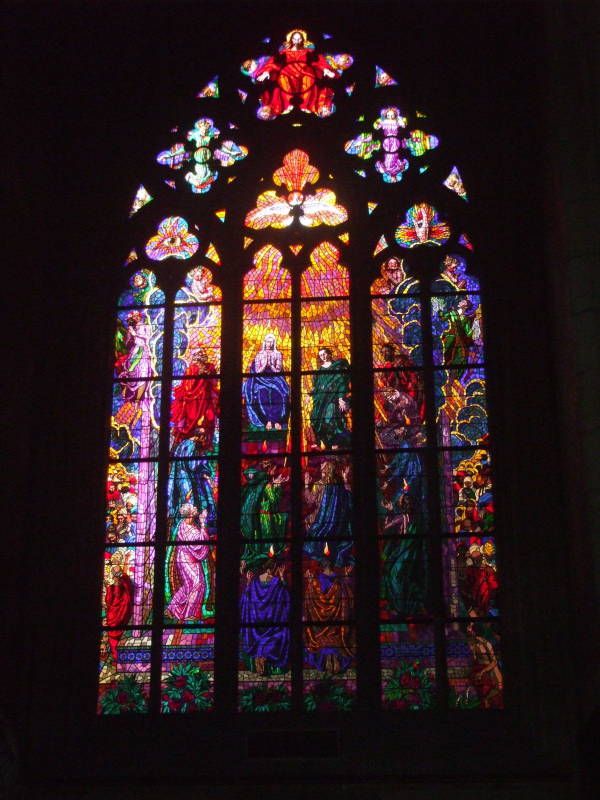
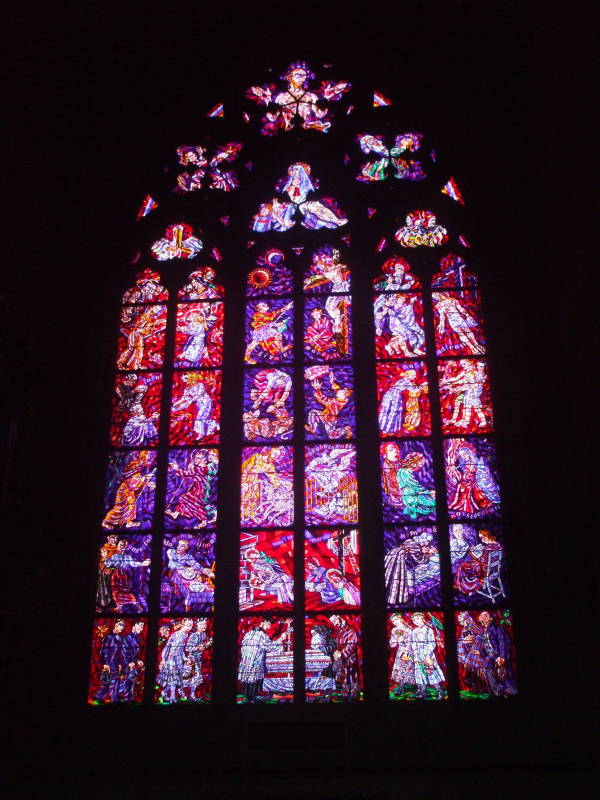
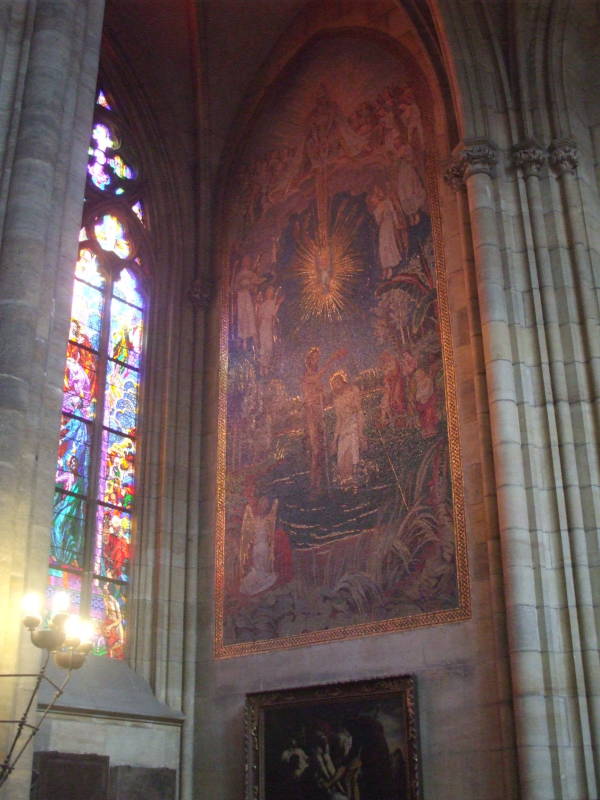
Some of the windows illuminate large mosaics.
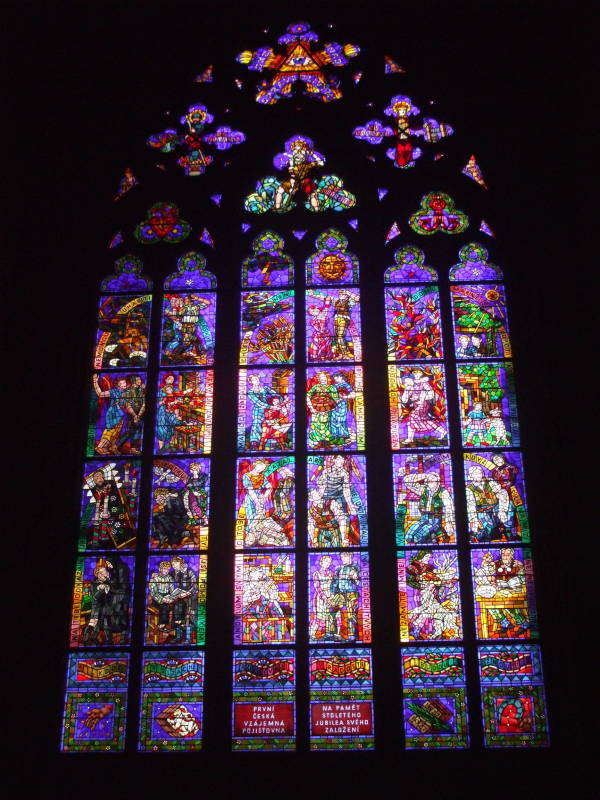
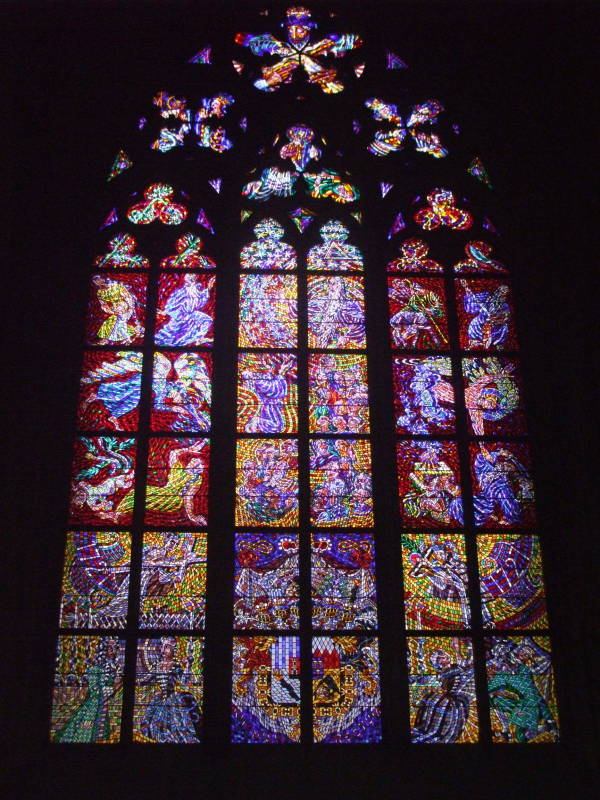
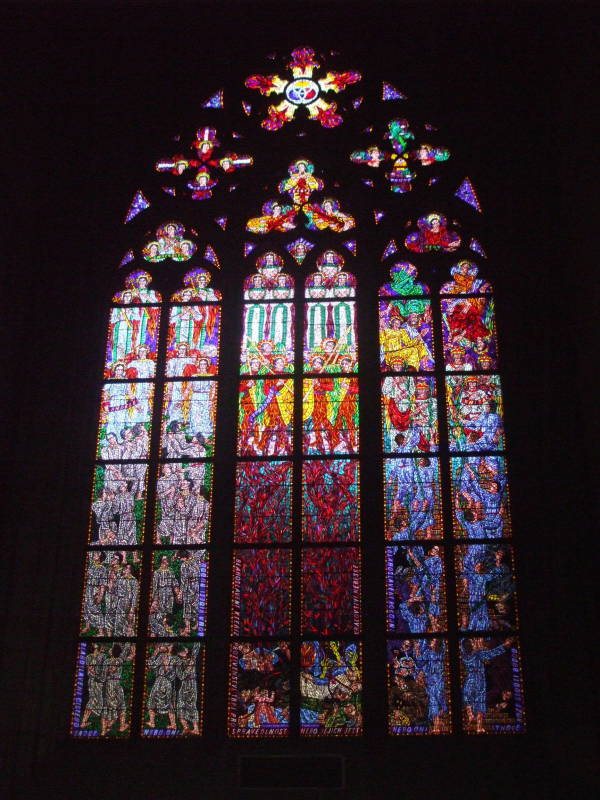
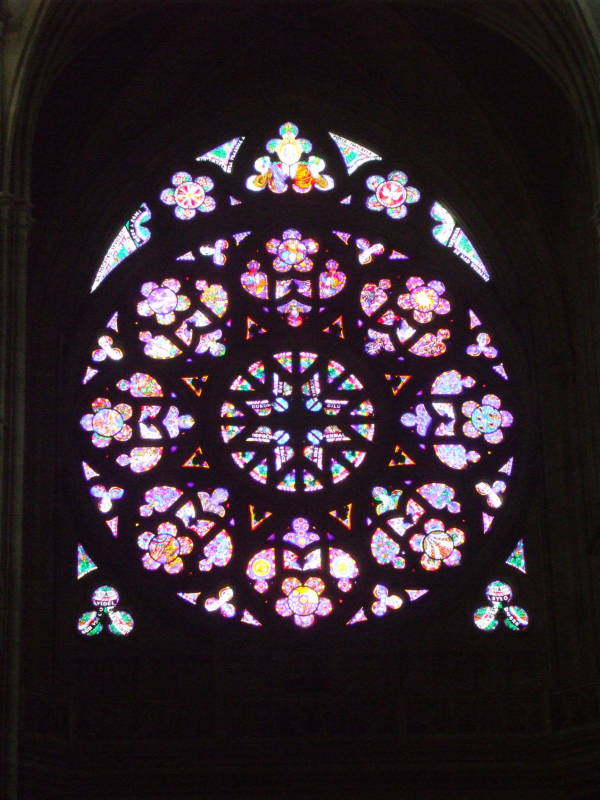
The Chapel of Saint Wenceslas contains the relics of Wenceslas, now a patron saint of Czech rulers, plus the bones labeled as belonging to Vitus.
The paintings of the life of Christ and the semi-precious stones on the lower walls date to the original decoration of the chapel in 1372-1373. The paintings on the upper walls show the life of Wenceslas, done in 1506-1509.
The Czech Crown Jewels are locked in the Crown Chamber, accessed through this chapel. The jewels are displayed to the public every eight years or so.
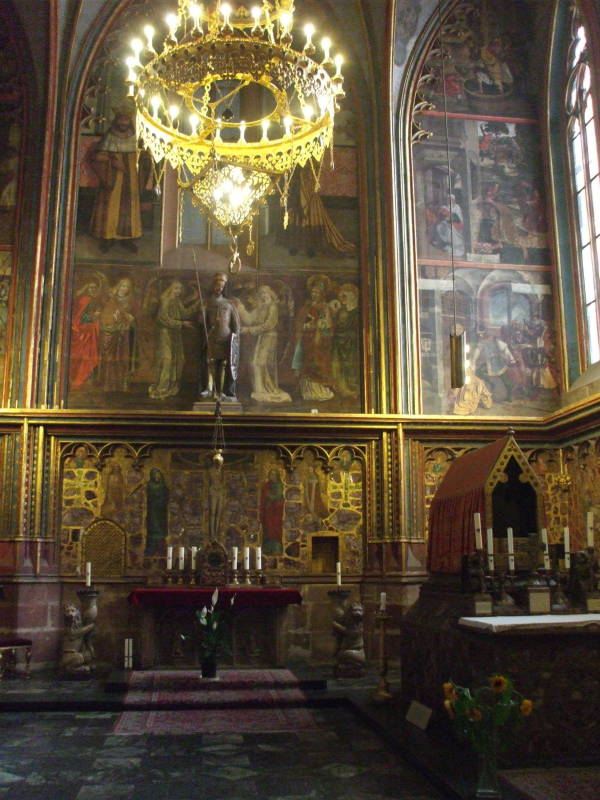
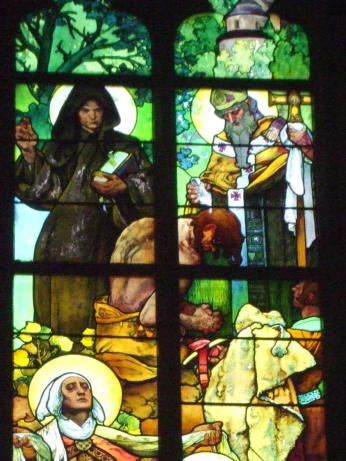
Alphons Mucha's stained glass window was my favorite part. The Czech Art Nouveau painter created this in the 1920s.
It has an unusual Christ in Majesty at the top, and the center third shows Cyril and Methodius, missionaries to the Slavic people and developers (or at least populizers) of the script used to write Slavic languages.
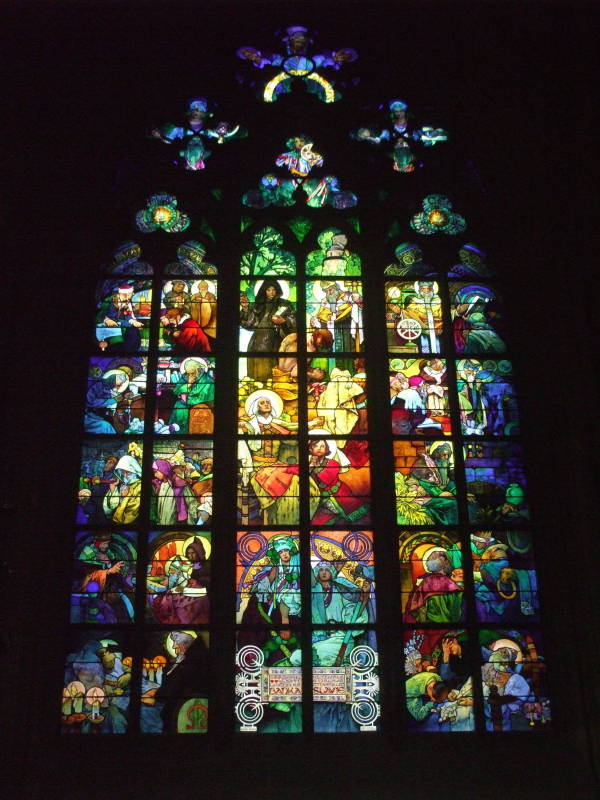
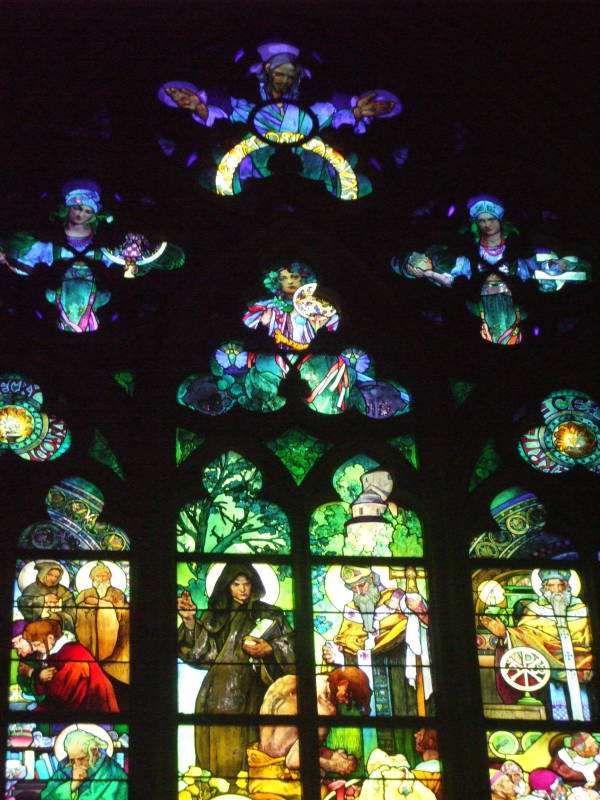
Christ looks sort of like Григорий Ефимович Распутин or Grigori Yefimovich Rasputin.
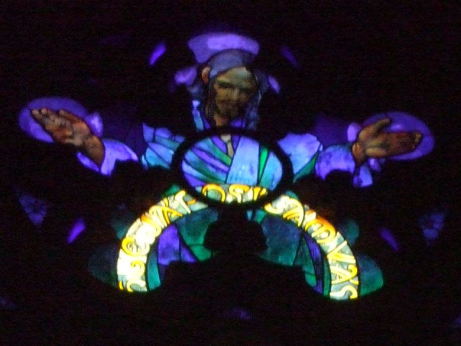
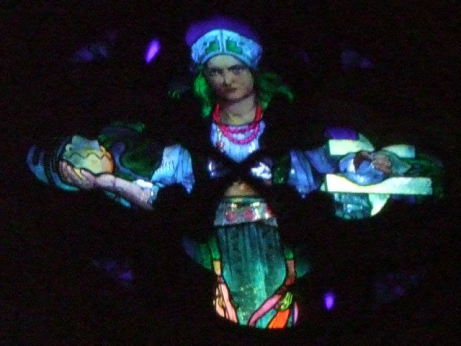
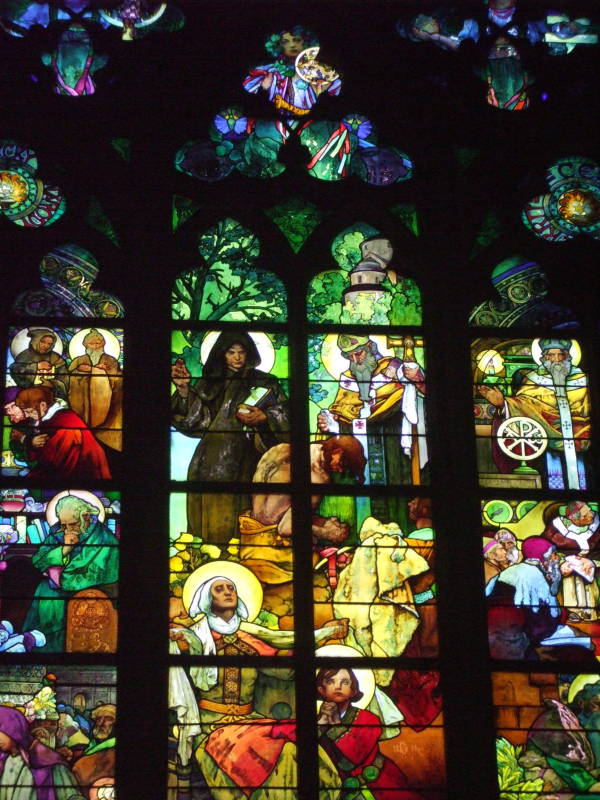
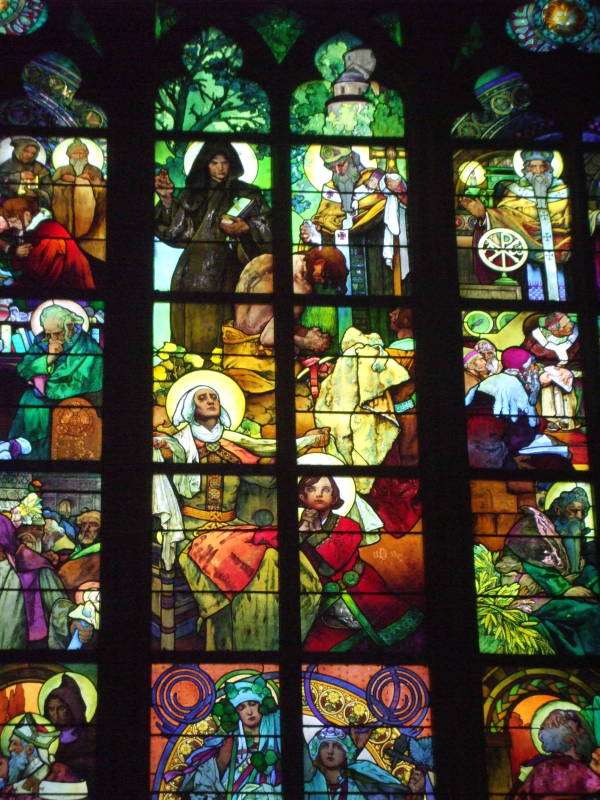
The center of the window shows the baptism of the archetypal Slavic Man by the brothers Cyril and Methodius.
Cyril and Methodius, originally Κύριλλος και Μεθόδιος in Greek, or Кѷрилль и Меѳодїй in the Old Church Slavonic script they had a hand in developing, were two brothers from Thessaloniki born in 826-827 and 815 AD, respectively. They became Christian missionaries to the Slavic peoples of southeastern and central Europe and in the process gave those peoples a unifying alphabet and sense of shared culture.
Their mother may have been Slavic, and they grew up speaking the Slavic language of the territory around Thessaloniki.
Lower on the window you can spot the archetypal Slavic Women.
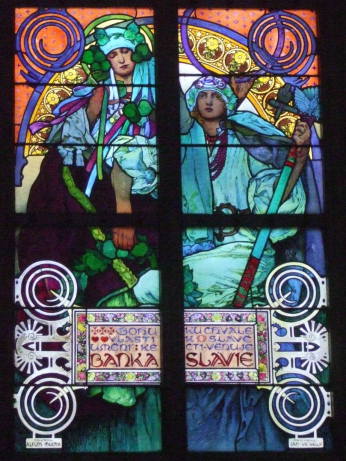
Amazon
ASIN: 1844517306
Cyril was well educated in theology and had learned Hebrew, Arabic and Samaritan. The Byzantine Empire sent him to the Abbasid Caliph al-Mutawakkil in Baghdad to discuss the Christian concept of the Holy Trinity with the Arab theologians. This was hoped to improve relations between the Byzantine Empire and the Abbasid Caliphate.
He was also sent to the Khazar Khaganate, a primarily Turkic people who controled a large territory north and east of the Black Sea. Khazaria was a buffer state between the Christians and Muslims, and its army incorporated Jews, Christians, Muslims and Tengriists when western Europe and the shores of the Mediterranean were routinely occupied with religious wars. At times they were allies of the Byzantines.
The Khazar royalty and nobility converted to Judaism in the early 800s. Cyril was sent to Khazaria in hopes of stopping what the Byzantines saw as a pernicious spread of Judaism, but he was unsuccessful.
It is claimed that Methodius accompanied his brother on his mission to Khazaria, but that is probably an invention of a biographer writing long after the fact.
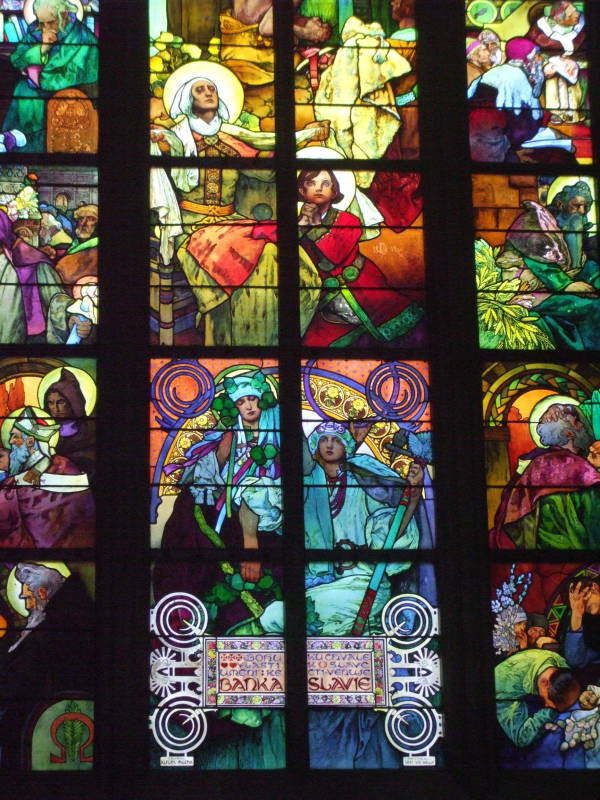
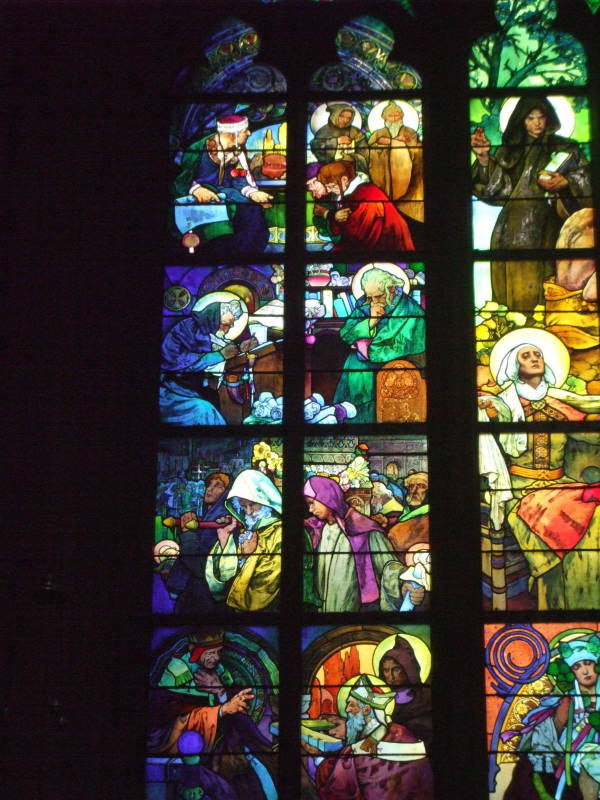
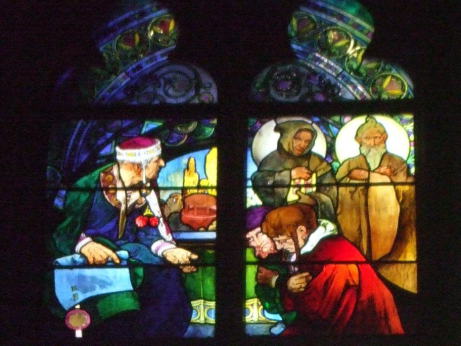
This picture depicts them meeting the Khan of Kazar.
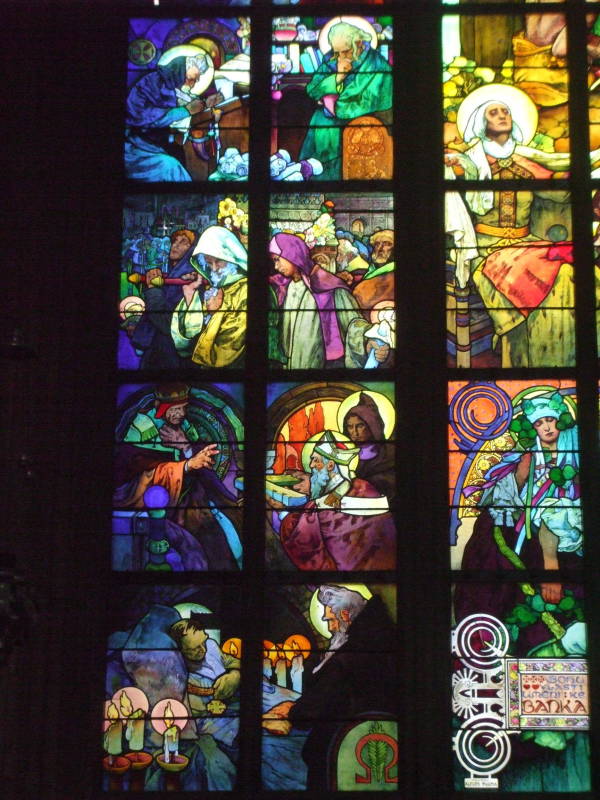
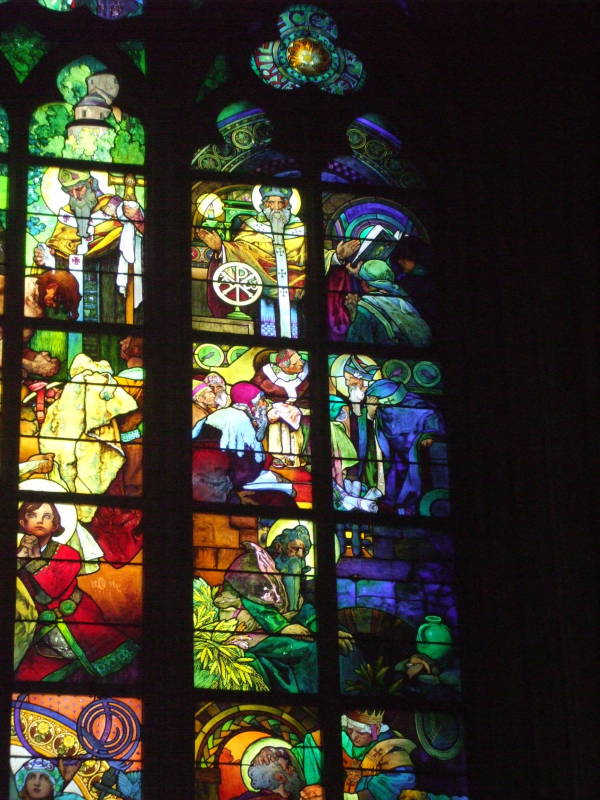
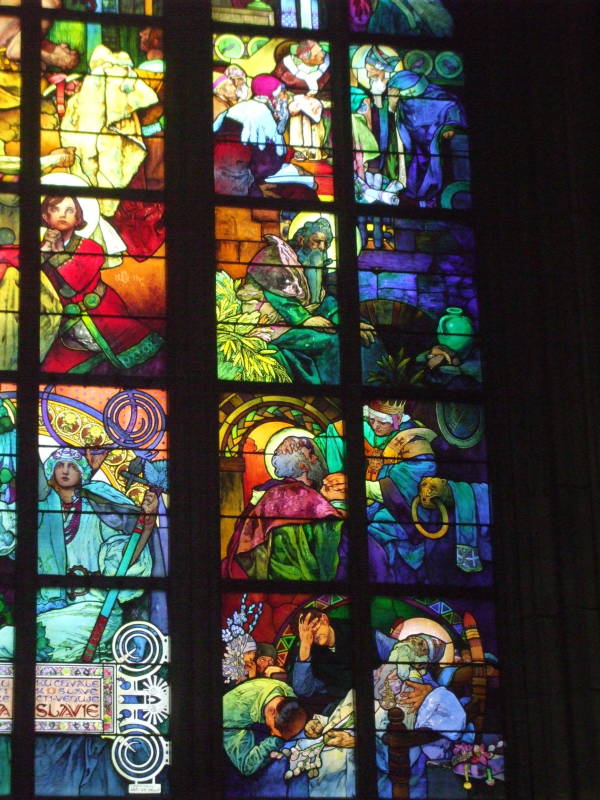
In 862 Prince Rastislav of Great Moravia asked the Byzantine Emperor Michael III and Photius the Patriarch of Constantinople to send some missionaries to his Slavic people. He wasn't happy with what he was getting from the Roman Catholic church, what with the associated pressure for political control being bundled with religion.
The Emperor sent the two brothers, who started by training some assistants and then by 863 were translating the Bible into the language now known as Old Church Slavonic. They developed, or at least were the first to use and popularize, the Glagolithic alphabet. They may have picked it up in the Crimea, where Cyril is said to have seen a Gospel and Psalter written in a script representing the local Rus' language.
The Cyrillic alphabet was developed from Glagolithic soon after that, taking its name from one of the brothers. Its development is attributed to Saint Clement of Ohrid, a follower of Cyril and Methodius. Not all of the resulting letters have lasted until today, see the purple Cyrillic letters plus Ѧ in the table below.
A few Cyrillic letters happen to look just like the equivalent Greek and Roman letters: А, Е, К, М, О and Т.
Others looks just like the equivalent Greek letters: В, Г, П, Р, Ф and Х.
Others are slightly modified versions of the Greek: Д, З, Л, С and У, and Б is pretty close.
Then there is the confusing pair: Cyrillic И and Н are analogous to Greek Η and Ν, respectively.
Then there are the squashed bug letters and other oddities of Cyrillic: Ж, Й, Ц, Ч, Ш, Щ, Ъ, Ы, Ь, Э, Ю, and Я, plus the extinct ђ, ћ, Ѡ, Ѣ, Ѥ, Ѧ, Ѩ, Ѩ, Ѫ, Ѭ, Ѯ, Ѵ, Ѷ, Ѹ, and Ѽ.
| Glagolithic | Cyrillic | sound |
| Ⰰ | А | a |
| Ⰱ | Б | b |
| Ⰲ | В | v |
| Ⰳ | Г | g |
| Ⰴ | Д | d |
| Ⰵ | Е, Э | ye,e |
| Ⰶ | Ж | zh |
| Ⰷ | Ѕ | dz |
| Ⰸ | З | z |
| Ⰹ, Ⰺ | И, Й | i |
| Ⰻ | І, Ї | i |
| Ⰼ | ћ, ђ | dj |
| Ⰽ | К | k |
| Ⰾ | Л | l |
| Ⰿ | М | m |
| Ⱀ | Н | n |
| Ⱁ | О | o |
| Ⱂ | П | p |
| Ⱃ | Р | r |
| Ⱄ | С | s |
| Ⱅ | Т | t |
| Glagolithic | Cyrillic | sound |
| Ⱆ | У | u |
| Ⱇ | Ф | f |
| Ⱈ | Х | kh |
| Ⱉ | Ѡ | o |
| Ⱋ | Щ | sht |
| Ⱌ | Ц | ts |
| Ⱍ | Ч | ch |
| Ⱎ | Ш | sh |
| Ⱏ | Ъ | uh |
| Ⱐ, Ⰺ | Ы | iy |
| Ⱐ | Ь | — |
| Ⱑ | Ѣ | a, ya |
| Ⱖ | Ё | yo |
| Ⱓ | Ю | yu |
| Ⱔ | Ѧ, Я | ya |
| Ⱗ | Ѩ | iya |
| Ⱘ | Ѫ | uy |
| Ⱙ | Ѭ | iuy |
| Ⱚ | Ѳ | f |
| Ⱛ | Ѵ | ih |
But I'm not complaining! Cyrillic is far more logical than Greek, which where there seems to be at least ten ways to form the sound represented by Cyrillic И, and where pronunciation depends on dipthongs and special cases all over the place.
The German clergy in Moravia, however, did complain. Not because of orthography, but because of a loss of political power. The Archbishop of Salzburg claimed ecclesiastical control of the territory and was insisting that it should use nothing but the Latin liturgy.
Pope Nicholas I invited the brothers to Rome in 867. The Pope actually took the side of the brothers and authorized the use of a Slavic liturgy. This meant that the people could actually understand their church services, something not possible outside the Byzantine east.
But of course this did not last. Latin was forcibly "restored" to people who never understood it in the first place, and the Germanic ecclesiastical structure gained control. The Great Schism of 1054 later ended any remaining ecumenical cooperation.
Staré Město and the Old Town Square
Staré Město, the Old Town of Prague (literally the Old Place), dates back to the 10th century and contains a wide mix of architecture.
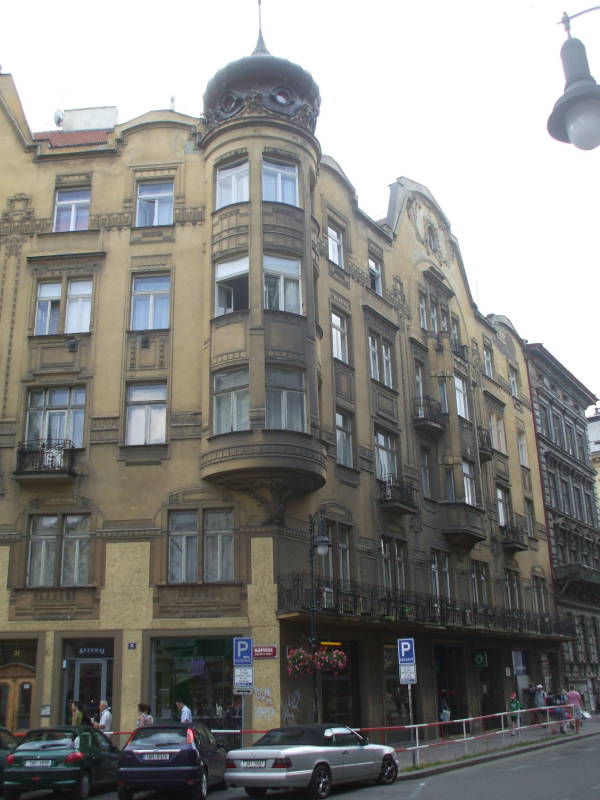
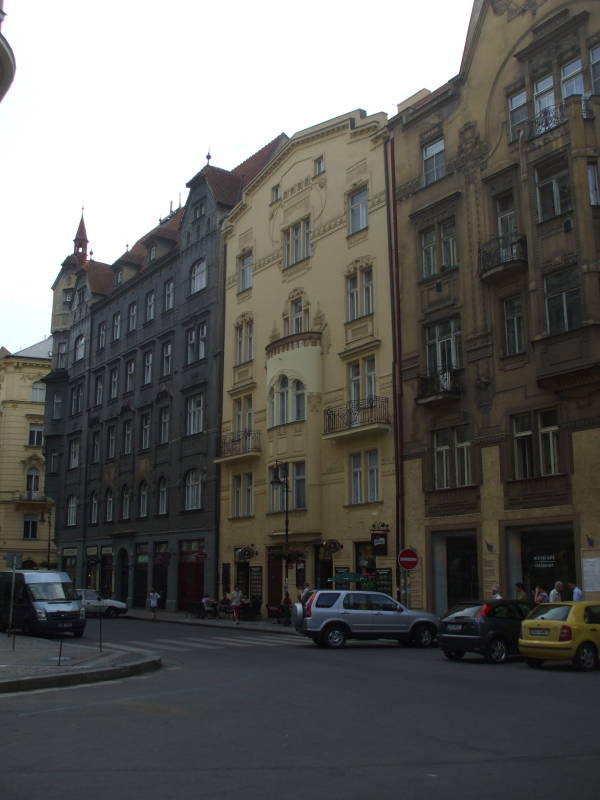
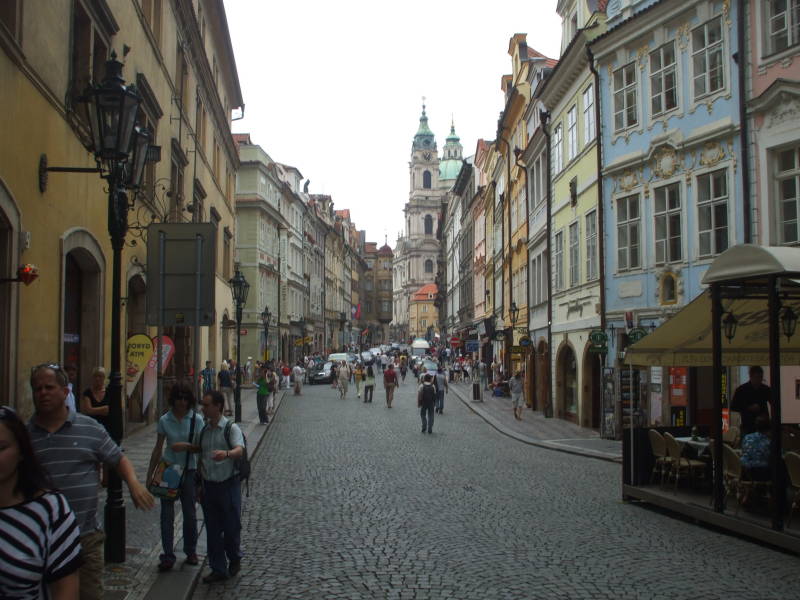
The Grand Hotel is one of many examples of Art Nouveau architecture, from the same period as the Mucha window in the cathedral.
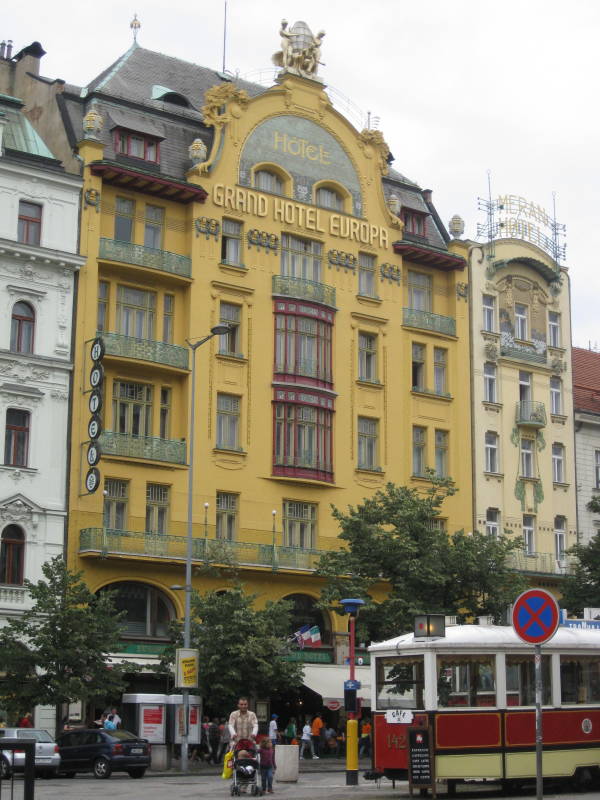
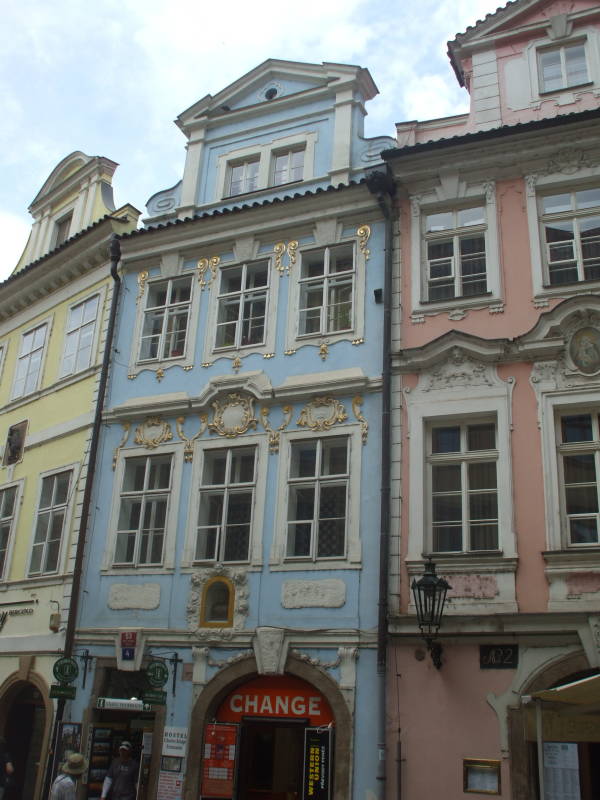
Staromeěstské Náměstí or the Old Town Square was the principal marketplace in Prague until the early 1900s.
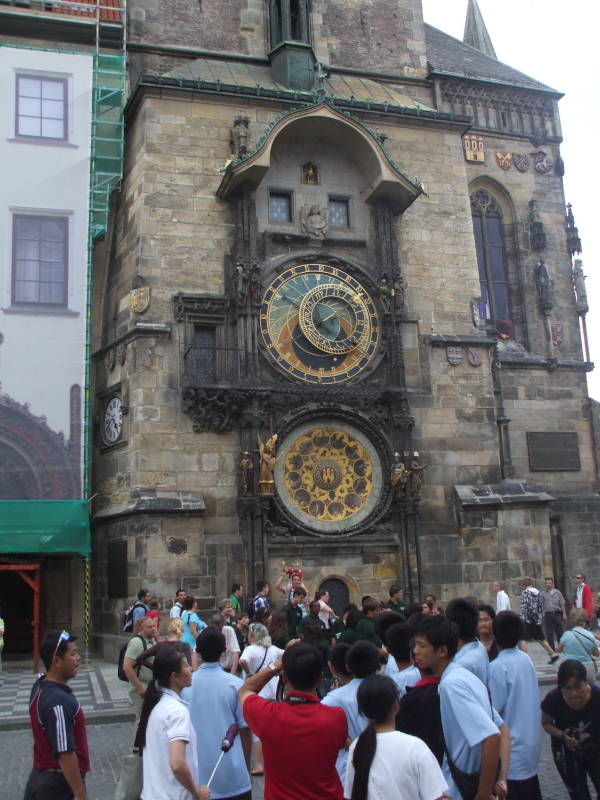
The elaborate clock on the Old Town Hall tower was built in 1490 by the clockmaker Master Hanuš. The legend you hear is that he was blinded immediately after so he could not build a similar one for any other city, and in revenge he crawled up into the clock and disabled it.
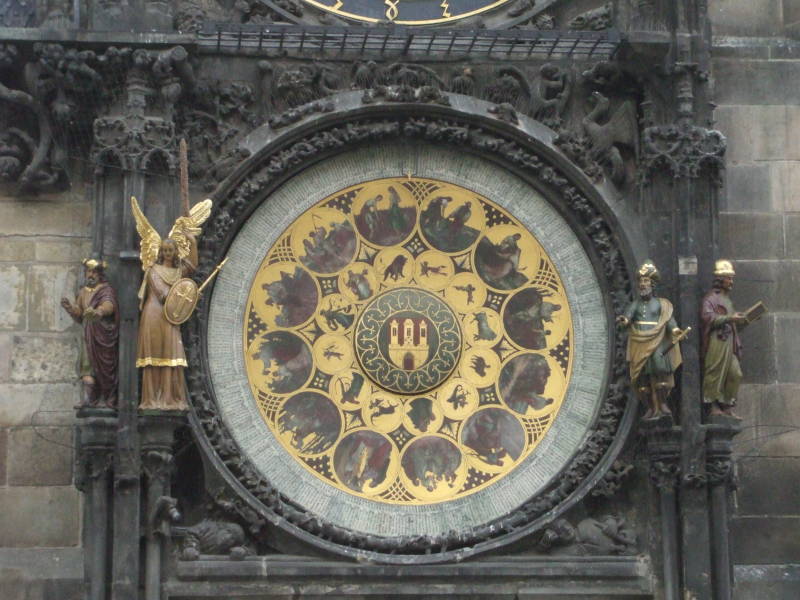
But historic documents show that he carried on his clockmaking work unblinded for many years. And he may not have been all that hot as a clock maker, because this example didn't work until someone else repaired it about 80 years later around 1570.
The clock puts on an elaborate mechanical show on the hour. However, no defenestrations are regularly scheduled.
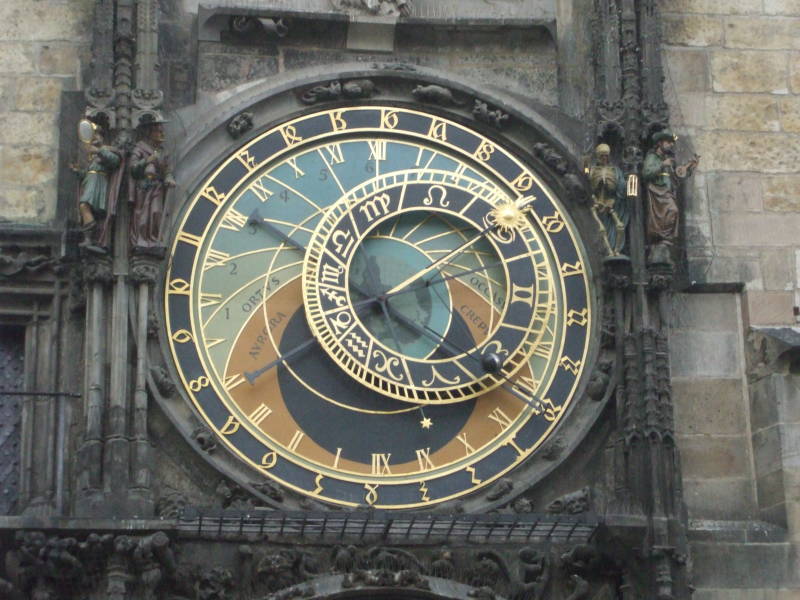
If you go to watch it, you will not be the only person there.
